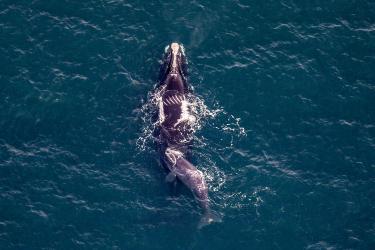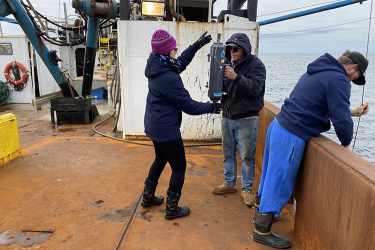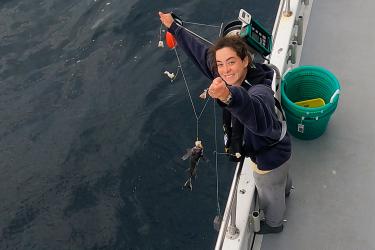The spring survey has officially begun, and I am on night watch with a great team! After a couple of nights to adjust to the sleeping schedule, we’re back in the full swing of sampling.
Not all fish are sampled the same. For some species, such as shortnose greeneye (Chlorophthalmus agassizi), only lengths are taken. For others, such as bluefish (Pomatomus saltatrix), we take length, weight, sex, maturity, stomach contents and otoliths. The bluefish pictured is a 46.5cm (just over 18 inches long) resting (after spawning) female.

A longfin squid and unidentified squid were found in the stomach (image below).

Since the otoliths (pictured below) for bluefish are very fragile, the heads are frozen so the otoliths can be taken out back at the lab.

This is the most common workup. There may also be additional requests from researchers inside and outside the lab for fin clips, gonad samples, muscle samples or whole frozen fish for identification, maturity, and stomach workshops.
For this leg, we’ve had some beautiful weather. On night watch, it’s sometimes easy to forget to go outside, but on those nice days, it’s wonderful to feel the sun and watch the water, hoping to catch a glimpse of a shark, fish, or pod of dolphins.

It’s not always sunny and calm, and we had a little window of unpleasant weather. When the waves and wind are too rough to fish, the main job becomes not flying out of your chair when the ship takes a roll, keeping your balance while walking, and trying not to get sick. If you’ve never been sea sick, count yourself lucky because it is miserable. But that’s just another part of life on a ship. Sometimes it’s really tough to be out here, but ultimately, it’s all worth it. There’s a lot of dedicated and excited scientists, volunteers, officers, deckhands and engineers who are all committed to gathering the best data possible, no matter what.
Christine Kircun
NEFSC Fishery Biology Program, Age and Growth Technician
Aboard the NOAA Ship Henry B. Bigelow
HB18-02-Leg 1



